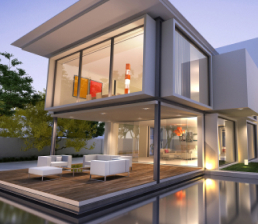
© 2022 Studio Inside Out. All rights reserved.
Climate-Responsive Design: What It Is and Why It Matters
Climate-Responsive Design: What It Is and Why It Matters
As we face increasing environmental challenges, the role of architecture and design in tackling these issues becomes more crucial than ever. Climate-responsive design is an innovative approach that addresses these concerns while enhancing the functionality and sustainability of our living spaces. Let’s explore what climate-responsive design is, its core principles, and why it’s so important for the future of architecture.
What Is Climate-Responsive Design?
Climate-responsive design, also known as climate-adaptive or climate-sensitive design, involves creating buildings and spaces that respond to the specific climate conditions of their location. This approach integrates environmental considerations into the design process to produce structures that are energy-efficient, comfortable, and sustainable. By using natural resources and adapting to the local climate, climate-responsive design aims to reduce the environmental impact of buildings.
Key Principles of Climate-Responsive Design
- Site Orientation and Layout
The way a building is positioned can make a huge difference in its energy efficiency. By orienting buildings to take advantage of natural light, ventilation, and shading, architects can significantly reduce energy use for heating, cooling, and lighting. For instance, in hot climates, buildings can be oriented to minimize direct sunlight, while in colder regions, maximizing solar gain can help with natural heating.
- Natural Ventilation
Utilizing natural ventilation can significantly reduce the need for mechanical cooling systems. Designing spaces with well-placed windows, cross-ventilation, and ventilated roofs improves airflow and indoor air quality, saving energy and promoting a healthier environment.
- Thermal Mass and Insulation
Using materials with high thermal mass, like concrete or brick, helps regulate indoor temperatures by absorbing, storing, and releasing heat. Proper insulation further enhances this effect, reducing the need for artificial heating and cooling, and ensuring a comfortable indoor climate year-round.
- Solar Design
Solar design involves using solar energy for both passive and active purposes. Passive solar design features, such as large south-facing windows and thermal mass, capture and store heat from the sun. Active solar systems, like photovoltaic panels, convert sunlight into electricity, providing a renewable energy source for the building.
- Rainwater Harvesting and Water Management
Efficient water management is a key aspect of climate-responsive design. Rainwater harvesting systems collect and store rainwater for various uses, decreasing reliance on municipal water supplies. Landscaping with native plants and permeable surfaces also helps manage stormwater runoff and support local ecosystems.
- Green Roofs and Walls
Green roofs and walls are not only visually appealing but also provide insulation, reduce the heat island effect, and improve air quality. These features contribute to energy savings, enhance biodiversity, and provide aesthetic and recreational benefits.
- Creative Use of Site Waste
At Studio Inside Out, we believe in turning challenges into opportunities. All site waste from our projects is converted into unique artwork. This not only minimizes waste but also adds a distinctive artistic element to our designs, showcasing our commitment to sustainability and creativity.
Why Climate-Responsive Design Matters
- Energy Efficiency and Cost Savings
By reducing the need for artificial heating, cooling, and lighting, climate-responsive design significantly lowers energy consumption. This leads to cost savings for building owners and reduces the overall demand on power grids, contributing to a more sustainable energy future.
- Environmental Impact
Climate-responsive buildings minimize the carbon footprint of construction and operation. By using local materials, renewable energy sources, and efficient design practices, these buildings help combat climate change and reduce environmental degradation.
- Enhanced Comfort and Health
Buildings designed with climate-responsive principles offer superior indoor comfort and air quality. Natural ventilation, temperature regulation, and access to natural light create healthier living and working environments, promoting well-being and productivity.
- Resilience and Adaptability
As climate conditions become increasingly unpredictable, buildings need to be resilient and adaptable. Climate-responsive design prepares structures to withstand extreme weather events, ensuring safety and longevity. This adaptability makes buildings more sustainable in the long term.
- Aesthetic and Community Benefits
Climate-responsive design often incorporates local cultural and environmental elements, resulting in buildings that harmonize with their surroundings. This approach fosters a sense of place and community, enhancing the overall quality of life for inhabitants.
By integrating environmental considerations into every aspect of design, we can create buildings that are efficient, resilient, and beautiful. At Studio Inside Out, we are dedicated to pioneering climate-responsive design solutions that meet today’s needs while protecting the planet for future generations.
If you’re interested in learning more about how climate-responsive design can benefit your next project, contact us at Studio Inside Out. Let’s work together to create spaces that are both innovative and sustainable.
Recent Comments
CATEGORIES
- Architecture (1)
- Exterior (1)
- Interior (4)
RECENT POSTS
#HELLIX







